new posts in all blogs
Viewing: Blog Posts Tagged with: James Preller school visits, Most Recent at Top [Help]
Results 1 - 12 of 12
How to use this Page
You are viewing the most recent posts tagged with the words: James Preller school visits in the JacketFlap blog reader. What is a tag? Think of a tag as a keyword or category label. Tags can both help you find posts on JacketFlap.com as well as provide an easy way for you to "remember" and classify posts for later recall. Try adding a tag yourself by clicking "Add a tag" below a post's header. Scroll down through the list of Recent Posts in the left column and click on a post title that sounds interesting. You can view all posts from a specific blog by clicking the Blog name in the right column, or you can click a 'More Posts from this Blog' link in any individual post.

By: James Preller,
on 11/10/2016
Blog:
James Preller's Blog
(
Login to Add to MyJacketFlap)
JacketFlap tags:
Tedd Arnold,
James Preller,
Matthew McElligott,
James Preller school visits,
5 Questions,
5 Questions Preller,
5 Questions with Matt McElligott,
Bob Berman astronomer,
Emily Easton editor,
Jason Gough,
The Mad Scientist Academy,
The Weather Disaster,
Add a tag
‘

–
Here we are, oh sunny day, the latest installment of my “5 Questions” interview series with luminaries of the children’s book world. Here comes my friend, Matt McElligott!
‘

Matt, I’m looking at the second book in your “Mad Scientist Academy” series, The Weather Disaster. And all I can think is, Boy that looks like a lot of work! Seriously, I’m exhausted. So I’m just going to take a brief nap and, yawn, we’ll pick this up later. Zzzzzzzzzz.
You’re not the first person to tell me my books put them to sleep!
Okay, I’m up! For readers who might be unfamiliar with this science series, you are essentially taking a nonfiction topic and giving it a fresh, contemporary spin. All told in an appealing format that’s a hybrid between the graphic novel and traditional picture book. As someone who has admired your work for many years, it strikes me that this series –- which is spectacular in every way — represents a culmination for you, a distillation of your many and varied talents. I don’t think you could have done this ten years ago. All of your past work informs this one book: your intellectual curiosity, your love of comic books and old Hollywood movies, your silliness, your experience with book design and storytelling, plus the signature McElligott sense of what kids genuinely like. How did this series begin?
The sentiment is much, much appreciated. And I agree completely -– I don’t think I could have done this ten years ago, and I’m not sure I could even do it now without the tremendous help of my wife Christy. It really is a lot of work. Not only does the story have to be compelling, but it also has to deliver a lot of real science along the way, hopefully while still captivating the reader. Finding that balance has been, by far, the trickiest part of putting these together, but I can honestly say I enjoy every part of it.

The idea began with a suggestion from my longtime editor, Emily Easton, who felt that there was a real opportunity for a new series that could make science accessible for kids. We spent about a year and a half trying out various ideas and approaches until it finally started to gel. The graphic novel format came from both my love of classic comics and a practical need to fit all the information into thirty-two pages.
There must have been a point, early on, when you thought to yourself, “Uh-oh.” Just that pure terror of, What have I gotten myself into? Can I actually do it?
Boy, you nailed it with that question. The feeling of terror hit me a couple weeks into the first book and has lingered ever since. There are roughly a hundred illustrations in each book, and the thought of how long it will take to draw the next book keeps me up at night. I’ll spend about a year, maybe a little more, researching, plotting, sketching, and illustrating pretty intensely until it’s finished. But the good thing is that I’m not in it alone. I happen to be married to a very talented woman who’s a whiz at both researching and drawing (we met thirty years ago in art school) and we can divide up many of the tasks to keep everything manageable. Three books in, and we’re still married!
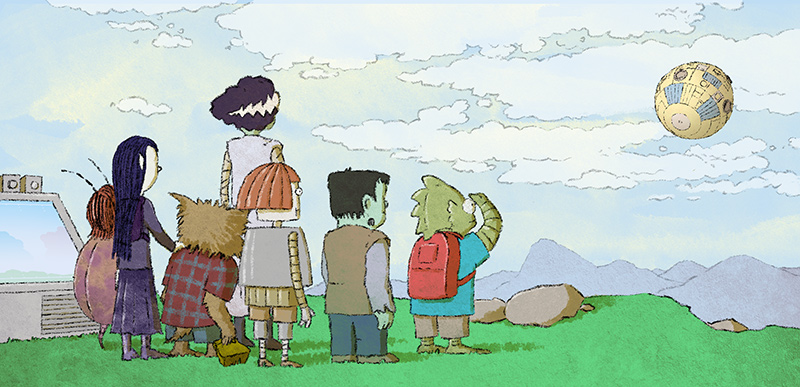
Now correct me if I’m wrong, but your cruel editors don’t allow you to just make up stuff for this book? Is that true? So you’ve actually got to know what you are talking about? What’s the research process like? In this book you thank an actual weatherman, Jason Gough. Otherwise known as a, cough-cough, “stratospheric meteorologist.”
Oh, no. I make most of it up. (That part about how rain forms? That totally came to me in a dream.) Seriously, there’s a ton of research for each book, and meeting real scientists has been one of my favorite parts. For The Weather Disaster I worked with Jason Gough, and for the Dinosaur Disaster I worked with a man named Carl Mehling, a paleontologist who’s in charge of all 32,000 fossils at the American Museum of Natural History. For the upcoming Space Disaster, I worked with the astronomer Bob Berman, who you may know from his work on the radio station WAMC.
All of these scientists were so helpful, patient, and fully willing to engage my strange questions. (“Say, Jason, if you needed to create a tornado from scratch, how would you do it?”) Best of all, they embodied a perfect combination of science and imagination, and I was really lucky to find them. I’ve posted interviews with Carl and Jason on my website, and will be posting more soon.
Matt, you and I are both active with school visits. And I always recommend you to media specialists. The funny thing is, they usually say, “Yeah, he was already here.” At which point I figure out that I’ve been invited because they are working their way down, down, down the list. Not that I mind playing second fiddle –- I’m happy to be in the orchestra! But talk to me a little about your experience in schools. I mean, there you are at home, slaving away on these impossible books. Then you get out of the house! What do you hope to achieve when you visit a school? And also, if you don’t mind me cobbling questions together, what do you think that you get out of your school visits?
Don’t sell yourself short –- you have quite a reputation in the schools! I suspect you’re there because the teachers are actually working their way up the list. (Preller? Why not? Anyone’s got to be better than McElligott.)
I get paid in Ramen Noodles and old Lotto tickets. I think that’s a big part of my appeal.
I love your questions about author visits. The first is pretty straightforward: I hope the kids see that authors are real people, that making books is a thing that real grownups do, and that the writing and illustrating process can be hard, but is totally worth it. (Authors, after all, get to control the world.)

On school visits, Matt always shows readers the joy of . . . the thrill of . . . nevermind!
As for what I get out of the visits, I’m not sure anyone’s ever asked me that. I know I get to share my love of books –- that’s a big part –- and get to meet future authors and illustrators, as well as terrific librarians and teachers. But I also get to represent something bigger than myself, a duty I take very seriously. When a school hosts an author, and when they present the author/illustrator as someone of importance, the school is sending a message about the value of the arts that kids are almost certainly not getting anywhere else. I’m honored to be that representative, if even for just a day.
I like that, we are ambassadors from a distant land. I’ve never been comfortable with the “rock star” aspect of being a visiting author. Sometimes we get put on a pedestal. But when you view it as beyond the self, that we are representing something bigger than “Jimmy” or “Matt,” then it makes more sense.
Ambassadors is such a great word for it. We may be the only authors some of those kids will ever meet. If we’re funny, if we’re engaging, if it shows that we love our jobs, they’ll assume that all authors are that way. Those kids will come away with the idea that reading and making books is something they want to do too.
I recall Tedd Arnold telling me in an interview that he enjoyed checking in with their “squirmy reality.” That phrase always stuck with me. You get to look at those faces, and interact, and reconnect with the fact that, hey, a second grader in October is still really, really young. The visits land us in their world. You know what? It’s like going on a safari! You drive the jeep, Matt. I’ll grab the pith helmets!

Exactly! It’s field research, and we can learn so much from studying the indigenous population of the elementary school.
You’ve tackled dinosaurs, you’ve wrestled with weather. What’s your next topic?
I can tell you that next up is The Solar System Disaster, out next summer. After that, maybe the ocean? Or maybe the science of belly-button lint. It’s probably between those two.
Well, I think we’ve all learned something today. Every book in this series is a disaster.
In more ways than one!
MATT McELLIGOTT keeps a terrific website which you can visit by clicking, madly, here.
AND IF YOU’D LIKE TO READ PREVIOUS “5 Questions” interviews, thank you — just click on the names below. Coming next week: Jessica Olien and her blobfish! And after that: London Ladd, Matthew Cordell, Lizzy Rockwell, Nancy Castaldo, Matthew Phelan, and more (but not necessarily in that order).
* Hudson Talbott
* Hazel Mitchell
* Ann Hood
-
Yesterday I cleaned out one of the bags I use for school visits. It’s surprising what I find in there. Old electric bills, paper scraps with hastily jotted-down ideas, Donald Trump’s taxes, lint-covered cookies (still delicious!), plus random notes and drawings that are handed to me by students mid-flight. As I rush down the hall seeking a bathroom, usually. The shy kid — with a friend, for bravery! — comes up and silently hands a paper to me. I am grateful, I am thankful, but I gotta go, so I stuff it into the bag, shake hands, and hurry to the next thing.
Thank you, sorry, gotta go.
Here’s one I wanted to share, because it’s all any of us ever really want. To feel noticed. To feel appreciated, recognized for our worth and our work. I am fortunate to enjoy a career where I am given notes like this one. Everyone should have that experience.

-
DEAR EDUCATORS,
An important and rewarding aspect of my career in children’s books is when I get out from behind my desk to visit schools. I very much enjoy meeting teachers and speaking with students, sharing my love of books. It’s also an important source of revenue for me as a writer. In truth, school visits allow me to keep doing what I love — writing books for young readers.
 After answering a series of individual emails on this topic over the past decade or so, I finally decided to get around to providing a general description of a typical visit. Hopefully it will help to answer questions in advance and give you some idea if I’m the right guy for your school.
After answering a series of individual emails on this topic over the past decade or so, I finally decided to get around to providing a general description of a typical visit. Hopefully it will help to answer questions in advance and give you some idea if I’m the right guy for your school.
I am relaxed and experienced speaking with students at any grade level, though, of course, the content of those talks varies according to age level. I’ve written a range of books that are appropriate for kindergarten up to middle school, and many of them available in paperback at affordable prices.
Typically, I’ll do three 45-50 minutes presentations during a full-day visit. In addition, schools sometimes like to set up lunches with a small group of students, and I’ve always enjoyed that. I am also very happy to sign books. It is understood that the sponsoring organization will handle all book sales.



For the best results, I’ve found that it makes a huge difference when students are familiar with my work and have thought about questions in advance. Like just about everything else in life, what you get out of it is in direct proportion to the energy that’s put into it. If the school leaders are excited and enthusiastic, that energy transfers to the students –- and we all have a terrific, rewarding experience.
 I don’t juggle, blow bubbles, or stand on my head. I’m an author talking about what I do for a living, reading a bit, answering questions, all (hopefully) in an authentic and entertaining fashion.
I don’t juggle, blow bubbles, or stand on my head. I’m an author talking about what I do for a living, reading a bit, answering questions, all (hopefully) in an authentic and entertaining fashion.
Fees are available upon request. I do try to be flexible to the specific needs of each individual school. For schools that require serious travel, it works best for me if 2-5 days worth of visits can be arranged with different schools in your district. Sponsors should plan on paying for travel expenses, which can be shared with other area schools. I can’t tell you how often I am asked to visit a school in, say, Montana. For one day. And sadly, that just never works; there has to be more of a coherent, cohesive plan to get me from here to you, way out there. That said, I’ve been to SC, FLA, CT, MA, NJ, PA, IL, MI, OH, OK, NY, and more. But my real dream is a week in San Francisco. So come on, folks, let’s make that happen!

Please Note, A Word About “Scary Tales” Series
 July, 2013, saw the launch of a new series of books for me, called SCARY TALES. I am very proud of these books, and I’m confident the books will reach even reluctant readers. They are best for grades 3-5, but these things are hard to pin down. As a visiting author, I fully recognize and respect that distinction between, say, a parent-purchased book in a store compared to a guest author in a school, where children do not have choice. Therefore, in a grade 2-3 presentation, I will talk about the series in terms of using the imagination, asking “what if?” questions, story-building and characterization. I do not dwell on anything particularly scary. At the same time, I will likely read a carefully-selected passage that gives readers a sense of the, um, literate creepiness of the books. I’m trying to say, I can work with you on this, not looking to scare young readers. I’m looking to inspire and motivate them. October makes for an especially fun time of year to highlight these stories (there are six in the series in all).
July, 2013, saw the launch of a new series of books for me, called SCARY TALES. I am very proud of these books, and I’m confident the books will reach even reluctant readers. They are best for grades 3-5, but these things are hard to pin down. As a visiting author, I fully recognize and respect that distinction between, say, a parent-purchased book in a store compared to a guest author in a school, where children do not have choice. Therefore, in a grade 2-3 presentation, I will talk about the series in terms of using the imagination, asking “what if?” questions, story-building and characterization. I do not dwell on anything particularly scary. At the same time, I will likely read a carefully-selected passage that gives readers a sense of the, um, literate creepiness of the books. I’m trying to say, I can work with you on this, not looking to scare young readers. I’m looking to inspire and motivate them. October makes for an especially fun time of year to highlight these stories (there are six in the series in all).
Middle Schools, Bystander, Anti-Bullying
The popularity of the book, Bystander, opened up new worlds to me, specifically middle schools. In many schools around the country, Bystander has been widely read and shared, sometimes with an entire grade or school,  featured in a “One Book, One School” context. The idea is that it can serve as a positive, educational springboard for conversations and activities about the dynamics of bullying, and the various roles we all play in those situations. But I stress: it’s a story, a work of fiction, and I have been a published writer of children’s books since 1986. (You remember ’86, don’t you?) So while I am thrilled and honored to speak to large and small groups about this book, and the issues within it, I am not an anti-bullying presenter. I don’t offer ten easy steps for bully-proofing your school. I don’t climb on the soapbox. I love to visit middle schools, I am fascinated and inspired by this age group (today, 2012, I share my home with a 6th-grader and an 8th-grader), and I care about this issue very deeply. But I approach it as a writer, if that makes sense.
featured in a “One Book, One School” context. The idea is that it can serve as a positive, educational springboard for conversations and activities about the dynamics of bullying, and the various roles we all play in those situations. But I stress: it’s a story, a work of fiction, and I have been a published writer of children’s books since 1986. (You remember ’86, don’t you?) So while I am thrilled and honored to speak to large and small groups about this book, and the issues within it, I am not an anti-bullying presenter. I don’t offer ten easy steps for bully-proofing your school. I don’t climb on the soapbox. I love to visit middle schools, I am fascinated and inspired by this age group (today, 2012, I share my home with a 6th-grader and an 8th-grader), and I care about this issue very deeply. But I approach it as a writer, if that makes sense.


NEW BOOKS
The Courage Test comes out in September, for grades 4-7. For more information on that book, a work of fiction which closely connects to the history of the Lewis and Clark Trail, this is a good place to start.
 The Fall, which serves as a strong companion to Bystander, will be available in paperback this September.
The Fall, which serves as a strong companion to Bystander, will be available in paperback this September.
If you wish, please feel free to write to me and we can chat about it in more detail.
For more on a James Preller-styled school visit, plus some advice of running a successful author visit, you should click here. Really, that will tell you all you need to know. But if you really dig research, go to the “School Visits” icon on the right sidebar, under “Categories,” and click madly, deeply.
Here’s one particular post you might find instructive.
So, there it is in a clamshell. I look forward to hearing from you!
Thanks!

Just wanted to share four terrific thank-you notes that I received after a school visit. I find that select teachers do that immediately after an author visit: they go back to the room, talk about what happened, and everybody writes. Sounds perfect to me. The debriefing is a valuable part of any new experience. What just happened? What did we learn? What did we like?
I love the artwork and the invented spellings. However, these comments do tend to make my visits sound something less than deeply pedagogical. All I can say, in my defense, is that it’s funny what makes an impression. Despite all my “valuable content,” most young readers respond best to the small details that make an author seem like an actual human being. And, of course, we remember the things that make us laugh.

“I liked the part when you said the diaper on the monkeys. It was funny.”
Comment: Um, does this need explanation? As in: Why is a visiting author talking about monkey diapers with our students? I guess you had to be there. But in this case, I gave an example of how a writer works. I needed to write a scene in a pet store, so I took my writer’s journal and visited a pet store. I looked around. I took notes. I found a cage of monkeys that were all wearing diapers. So I put it in the book, Jigsaw Jones: The Case of Hermie the Missing Hamster. The word diaper always gets an easy laugh.

“I liked the pat when you said drive me bananas. I liked every part.”
Comment: Those bananas look suspiciously like giant pieces of macaroni to me. But how about that last line? So sweet. “Evre part.”

“I liked when you said that our grandma was wearing a dead animal on your grandma.”
Comment: Well, Dean, that wasn’t exactly what I said. But, yes, it’s true. My grandmother wore a mink stole fur wrap. It both fascinated and terrified me.

Comment: The artwork in this one, by Lauren, is just insanely amazing. And again, yes, this is true: early in talks, I sometimes joke to the little ones that if they call out and raise their hands while I’m trying to talk, that it will drive me bananas and I might jump out the window. Together we agree that wouldn’t be a great way to conclude an author visit — with a trip to the hospital. I ask to save their questions for the end. And then they ask me probing questions like, “I have a dog named Daisy, too.”
I’ve been visiting schools lately as a guest author, speaking to grades K-8, traveling from Buffalo to Binghamton, Rochester to Wallkill, and places in between. Here’s a variety of images from those visits. Maybe this composite will offer an inkling of the “school visit” experience. I especially appreciate the posters and student artwork that’s created in anticipation of “the big day.” Feeling honored, grateful, and a little fried. (And, yes, still full from my first taste of “breakfast pizza” — it’s a Buffalo thing.) Thank you all for making these visits possible. I know that someday the phone won’t ring, there will be no invitations, no email queries. For now, during these good times, I feel privileged to be welcomed into so many schools, and to see those young faces, and to try to make each place I visit just a little bit better than it was the day before.























-
There’s nothing particularly outstanding here, but I thought I’d throw up a few snaps from recent school visits and walk you through a typical arrangement.

Yes, that’s truly “a good sign” for any author visit. It is welcoming and shows that the school has invested time and thought into the visit. I’ve said it a thousand times: Authors don’t do school visits, schools do author visits.
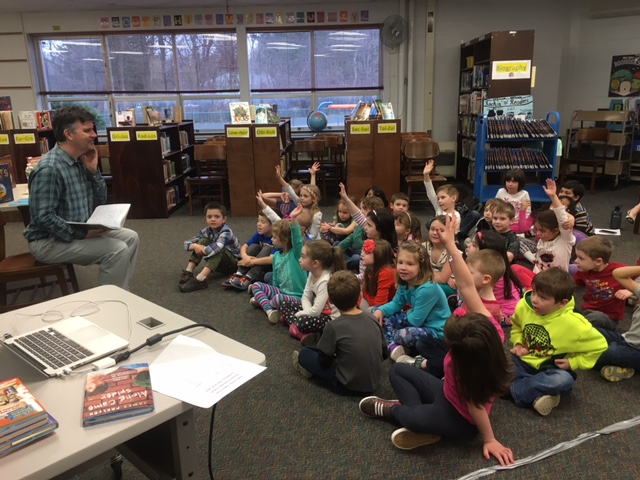
I visit elementary schools and middle schools. Next week, for example,I’ll even be speaking to 380 students in one packed auditorium, grades 7-12. When I visit traditional K-5 elementary schools, I try to arrange to meet with K-only groups for shorter, more intimate visits. Then I’ll see groups of grades 1-2, grades 3-4, and grade 5 only. My material and message seems to fall in line with those groupings.

When I see grades 5-only, it allows me to include in my presentation a bit about Bystander and bully-themed issues. It’s a little older, more mature, a little deeper.

For K-only, I’ve learned that it’s best to sit in a chair, speak softly and gently. I tell kids how the bear in Wake Me In Spring reminds me of my father, snoring in his big, comfortable chair.
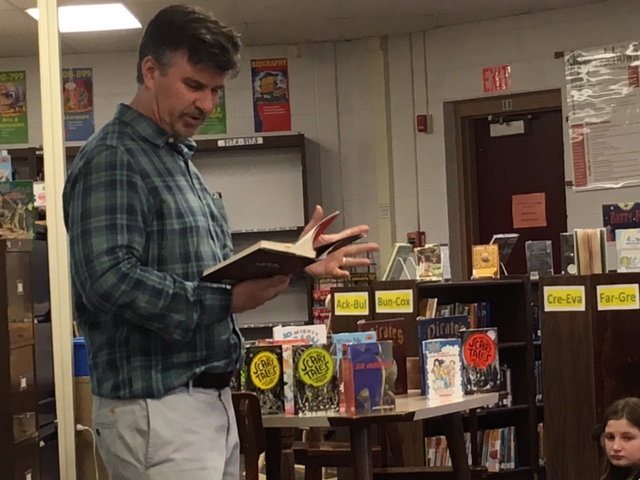
Reading from the first chapter of Bystander. I’ve pretty much got that thing memorized.

This is a grades 3-4 group, where they are extremely enthusiastic about “Scary Tales.” We talk a lot about the creative process here, building a story. The photo on the screen is of a swamp. I’m talking about the setting of one of my stories, one of the basic building blocks of any story: where, who, what; setting, character, plot. For grades 1-2, I tend to center it around Jigsaw Jones and writing from real life.

By: James Preller,
on 6/26/2015
Blog:
James Preller's Blog
(
Login to Add to MyJacketFlap)
JacketFlap tags:
Alanna Almstead,
duct tape librarian,
Ichabod Crane Primary School,
Ichabod Crane School District,
Solving the problem of unreturned library books,
Suzanne Guntlow,
The hilarious way one librarian,
Valatie NY,
School Visits,
James Preller school visits,
Add a tag
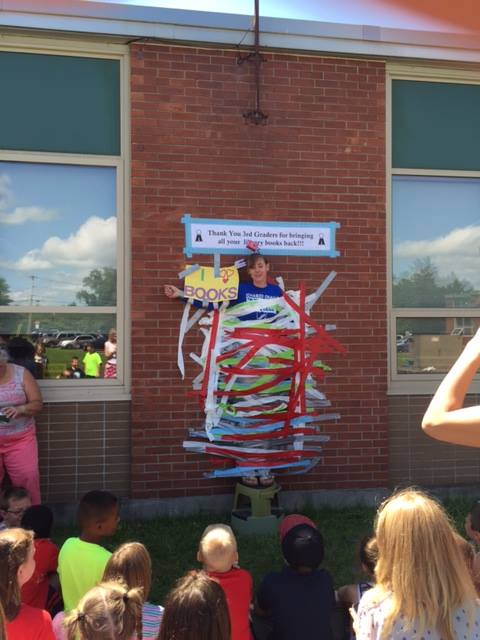
Her name is Alanna Almstead. She’s a librarian at Ichabod Crane in Valatie, NY. And at the end of each school year, Alanna faces the same vexing problem: Unreturned library books.
Because kids tend to forget. And some others, let’s hope, just fall in love with that book and can’t stand the thought of letting it go.
Alanna realized that the problem might be solved if she could only provide the proper motivation. Some sort of incentive. A carrot, so to speak.
But what could it be?
Here, I’ll let my friend Alanna explain it in her own words:
“The idea actually came about last June as my amazing aide, Lori, and I were discussing the shameful number of missing books at the end of the year. Always eager to see me make a fool of myself, I think the words “duct tape” first came out of her mouth.
Fast forward to May of this year. There I sat rambling at the end of a particularly fun library class about how important it was to return their books (we also give funny trophies to the five classes that return all of their books the fastest) when I suddenly blurted out that if the whole school brings their books back I would get taped to the wall. Yikes! Once that sort of thing gets said there is no taking it back, but no worries… It will never happen, I thought to myself.
 I approached my principal, Suzanne Guntlow, after the fact. Suzanne is a wonderful supporter of the library and gave me her blessing, just in case the kids came through.
I approached my principal, Suzanne Guntlow, after the fact. Suzanne is a wonderful supporter of the library and gave me her blessing, just in case the kids came through.
And come through they did! Although we fell short of the goal of all books returned school wide I am very happy with the results. In the end we had only 12 books still checked out in a building serving over 560 students. When the last third grader brought her book back I knew that I would have to make good on my promise.
And so, on the eve of the last day of school, I found myself making the rounds to several local stores to buy armfuls of duct tape. Variety seemed important, for some reason. When you’re nearly 6 feet tall and are faced with getting stuck to a wall you want the tape to work (and look pretty, of course!).
All of the third grade classes gathered on the last day of school to witness their reward for being so responsible. Afterwards I did hear a few students saying that it was the “best way to end the year.” (What does that say about what they really think of me, I wonder?!?).”
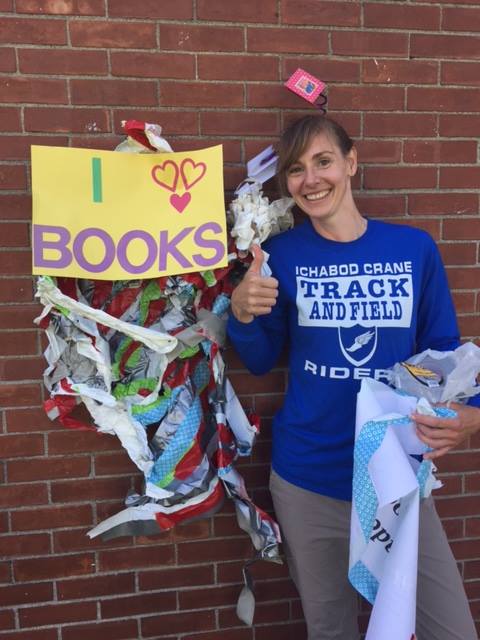
Final comment: I think it’s pretty obvious what they think of you, Alanna. Those kids think their school librarian is a hoot. Great job, great spirit. And a huge hat tip to that incredible aide, Lori, for hatching the idea. Note: Yes, there’s actually a brief video of the moment when they removed the foot stool from beneath Alanna’s feet and — what joy, what laughter — she stuck!

-
When I visit schools — which is often, and always gratefully — if time allows we’ll arrange for me to enjoy lunch with an intimate group of students. It’s always relaxed and informal, just talking, hanging out together, trading desserts. In some groups the conversation turns to literary concerns, but more often we just sort of chat, talk about ourselves, and try to crack each other up. I like it because, finally, it’s not strictly about me, me, me. My power point, my dumb books. These visits become more about them, and the truth is that I’m probably more comfortable that way. I’m surely more entertained.
Anyway, there was a white board in the room earlier in the week. Toward the end, as the principal was trying to pry the students away, a few of them wandered over to the board to write brief messages. I snapped a photo of these two, just to share with you, My Mighty Nation of Readers!
Sweet, huh?
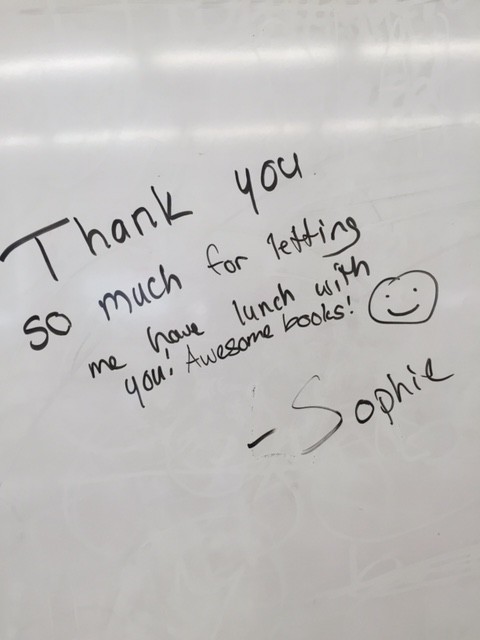
Sophie, you are welcome, the pleasure was all mine.
And Elizabeth, I’m not offended at all. There’s so many great books out there, I’m just glad you picked one of mine.

By: James Preller,
on 11/3/2014
Blog:
James Preller's Blog
(
Login to Add to MyJacketFlap)
JacketFlap tags:
Acts of Mischief in Children's Literature,
Fuse 8 blog,
Kirkus online,
The bully label,
Seven Impossible Things Before Breakfast,
Betsy Bird,
The Fall,
Wild Things,
Scary Tales,
Preller Bystander,
Julie Danielson,
James Preller school visits,
James Preller Interview,
Peter D. Sieruta,
Iacopo Bruno,
The one-eyed doll,
Preller Scary Tales,
Preller THE FALL,
Interviews & Appreciations,
Best scary books for young readers,
Add a tag
-
The article below came out the day before Halloween over at the Kirkus Reviews blog. It was written by the fabulous Julie Danielson, who also writes one of the best blogs in the whole dang internet: Seven Impossible Things Before Breakfast. Check it out, bookmark it, love it. Julie also has a new book out, co-written with Betsy Bird (of Fuse 8 fame) and the late, great Peter D. Sieruta.

I haven’t read this one yet, by the firm of Bird, Danielson & Sieruta, but it’s high on my reading list.
But enough about those guys. Let’s bring this conversation back to me, me, me.
-
————
-
-
Tomorrow is Halloween, and author James Preller wants to scare your children—the safe, exhilarating type of scare, that is, which comes from a well-constructed set of spooky stories just for the younger set. He’s been doing this not just on Halloween but all during the year with Scary Tales, his chapter book series of ghost stories, launched last year and illustrated by Iacopo Bruno.Chilling and thrilling and very often spine-tingling, the series offers up serious page-turners for students who enjoy reading frightening tales while on the edge of their seats. It’s a far cry from Preller’s Jigsaw Jones series of chapter books, which debuted in 1998, the beloved fictional detective stories for children that are still circulating in libraries. The latest and fifth book in the Scary Tales series, The One-Eyed Doll, was just released. It brings readers hidden treasures, deserted houses, and a creepy one-eyed doll, who moves and tells stories. Needless to say, it’s a good fit for Halloween—or, really, any time of year.Next year, Preller will also see the release of a middle-grade novel, one that follows 2009’s Bystander, which the Kirkusreview called “eminently discussable as a middle-school read-aloud.” The Fall, as you’ll read below, addresses bullying, but not for the sake of jumping on the bullying bandwagon. That’s to say that as soon as many schools kicked off anti-bullying crusades in recent years, we suddenly saw a flock of books about bullying in the realm of children’s literature. But Preller isn’t one for the “bully” label.Let’s find out why.
-
The Scary Tales series started in 2013, yes? How much fun has it been to scare the pants off of readers?
-
 Writing “scary” has been liberating. A blast. In the past, I’ve mostly written realistic fiction. But for these stories I’ve tapped into a different sort of imagination, what I think of as the unpossible. The trick is that once you accept that one impossible element—a zombie or a ghost in the mirror—then the story plays out in a straightforward manner.All storytelling has its backbone in realistic fiction.
-
So many kids, even at a surprisingly young age, are eager to read scary stories. I tried to fill that gap. “Scary” thrills them. It makes their hearts beat faster. Yet I say to students, “I’m sorry, but nobody gets murdered in these books. There are no heads chopped off. No gore.” To me, the great sentence is: The door knob slowly, slowly turned. That delicious moment of anticipation, of danger climbing the stairs. I’ve tried to provide those chills, while still resolving each book in a safe way.
-
You do a lot of school visits, as I understand it. What do you see the very best teachers and librarians doing (best practices, if you will) that really get children fired up about reading?
-
In its essence, teaching is enthusiasm transferred. The best educators seem to do that naturally—the excitement, the love of discovery. It leaks into everything they do. I think it’s about a teacher’s prevailing attitude, more than any specific activity.
-
Speaking of school visits, I assume you still visit schools to discuss Bystander, especially given the subject matter. How have middle-schoolers responded to that book in school visits?
-
Writing “scary” has been liberating. A blast. In the past, I’ve mostly written realistic fiction. But for these stories I’ve tapped into a different sort of imagination, what I think of as the unpossible. The trick is that once you accept that one impossible element—a zombie or a ghost in the mirror—then the story plays out in a straightforward manner.All storytelling has its backbone in realistic fiction.
-
So many kids, even at a surprisingly young age, are eager to read scary stories. I tried to fill that gap. “Scary” thrills them. It makes their hearts beat faster. Yet I say to students, “I’m sorry, but nobody gets murdered in these books. There are no heads chopped off. No gore.” To me, the great sentence is: The door knob slowly, slowly turned. That delicious moment of anticipation, of danger climbing the stairs. I’ve tried to provide those chills, while still resolving each book in a safe way.
-
You do a lot of school visits, as I understand it. What do you see the very best teachers and librarians doing (best practices, if you will) that really get children fired up about reading?
-
In its essence, teaching is enthusiasm transferred. The best educators seem to do that naturally—the excitement, the love of discovery. It leaks into everything they do. I think it’s about a teacher’s prevailing attitude, more than any specific activity.
-
Speaking of school visits, I assume you still visit schools to discuss Bystander, especially given the subject matter. How have middle-schoolers responded to that book in school visits?
-
 The response to Bystander has been incredible—and humbling. Many middle schools have used it as their “One School, One Book” community reads, which is such an honor.I attempted to write a lively, unsentimental, informed, fast-paced story. I hope that I’ve given readers something to think about, while leaving them to draw their own conclusions. I didn’t write a pamphlet, 10 steps to bully-proof your school. Robert McKee, in his book Story, says that stories are “equipment for living.” I believe in the power of literature to help us experience empathy.
-
What’s next for you? Am I right that there’s a new Scary Tales coming out in 2015, as well as a new novel? Working on anything else you’re allowed to discuss now?
-
I have an ambitious hardcover coming out next year, titled The Fall (Macmillan, Fall 2015), in which I return to some of the themes first explored in Bystander. We’ve seen “the bully” become this vilified subcreature, and in most cases I don’t think that’s fair or accurate. Bullying is a verb, a behavior, not a label we can stick on people to define them—especially when we are talking about children. Walt Whitman wrote, “I am large, I contain multitudes.”The book is told in a journal format from the perspective of a boy who has participated in bullying—with tragic results—and now he’s got to own it. A good kid, I think, who failed to be his best self. To my surprise, the book ended up as almost a meditation on forgiveness, that most difficult of things. The opening sentence reads:
The response to Bystander has been incredible—and humbling. Many middle schools have used it as their “One School, One Book” community reads, which is such an honor.I attempted to write a lively, unsentimental, informed, fast-paced story. I hope that I’ve given readers something to think about, while leaving them to draw their own conclusions. I didn’t write a pamphlet, 10 steps to bully-proof your school. Robert McKee, in his book Story, says that stories are “equipment for living.” I believe in the power of literature to help us experience empathy.
-
What’s next for you? Am I right that there’s a new Scary Tales coming out in 2015, as well as a new novel? Working on anything else you’re allowed to discuss now?
-
I have an ambitious hardcover coming out next year, titled The Fall (Macmillan, Fall 2015), in which I return to some of the themes first explored in Bystander. We’ve seen “the bully” become this vilified subcreature, and in most cases I don’t think that’s fair or accurate. Bullying is a verb, a behavior, not a label we can stick on people to define them—especially when we are talking about children. Walt Whitman wrote, “I am large, I contain multitudes.”The book is told in a journal format from the perspective of a boy who has participated in bullying—with tragic results—and now he’s got to own it. A good kid, I think, who failed to be his best self. To my surprise, the book ended up as almost a meditation on forgiveness, that most difficult of things. The opening sentence reads:
“Two weeks before Morgan Mallen threw herself off the water tower, I might have sent a message to her social media page that read, ‘Just die! die! die! No one cares about you anyway! (I’m just saying: It could have been me.)”
I was guided throughout my writing by a powerful quote from the great lawyer and activist Bryan Stevenson: “I’ve come to understand and to believe that each of us is more than the worst thing we’ve ever done.”
THE ONE-EYED DOLL. Copyright © 2014 by James Preller. Illustrations copyright © 2014 by Iacopo Bruno and used by permission of the publisher, Feiwel & Friends, New York.
Julie Danielson (Jules) conducts interviews and features of authors and illustrators at Seven Impossible Things Before Breakfast, a children’s literature blog primarily focused on illustration and picture books.
Came across this today and thought it would make a good slide for my Middle School presentations. It basically expresses where I come out on all the tips and strategies for so-called “Bully Proofing” a school. It’s why these students don’t need to be preached to. They already know. They just need to be encouraged to listen, and supported when they do.
When my presentation is over — which is decidedly not about bully-proofing a school, it’s about writing books — I like to keep up a final slide while the students filter out. Most of my slides are just images, not words. But at the end, I think that last slide can have words. This one just might make the cut.
Thank you, Shel Silverstein!
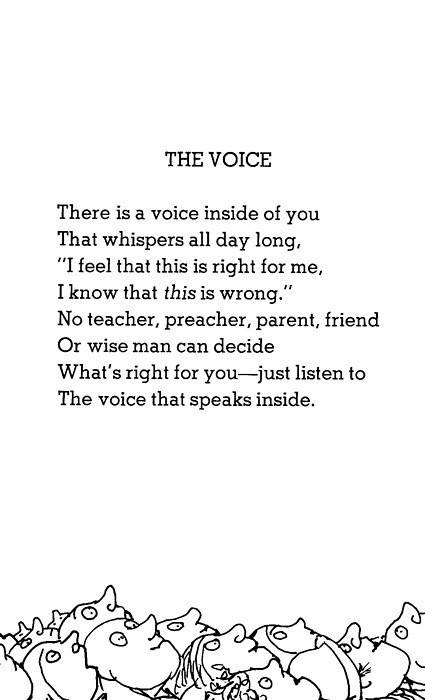

By: James Preller,
on 5/22/2012
Blog:
James Preller's Blog
(
Login to Add to MyJacketFlap)
JacketFlap tags:
Nicholas D. Kristof,
James Preller school visits,
John Winthrop middle school,
R.J. Palacio,
Wonder R.J. Palacio,
Lena Rawley,
Madison Jaronski,
New Hope PA,
One book one school bystander,
Romney bullying,
sick & tired of anti-bullying,
The New York Times Kristof,
trudeau,
Winning essays bullying,
Add a tag
I’ll admit it. Sometimes I have doubts. Not about bullying, exactly — I know it’s a serious issue, a matter of life and death — but I fret about the effectiveness of talking about it.
You could call it an occupational hazard.
Does anyone hear the message anymore?
Anti-bullying rhetoric seems everywhere these days. Trending hot on Twitter. Almost fadish. And I sometimes wonder if kids have tuned it out. In my travels, I’ve talked to many teachers who have expressed that worry.
This year, I’ve visited schools in OH, MA, FLA, MI, NJ, NY, SC, PA, and CN — often because I wrote the book, Bystander. A children’s author, I’ll arrive at a school where all the middle schoolers, grades 6-8, have read and discussed my book. They’ve wrestled with the issues, hopefully identified with characters, felt compassion, empathy, anger. Or, I guess, some of them have just been bored by another book they didn’t get to select themselves. In most cases, my novel is only one small piece of a comprehensive anti-bullying agenda.
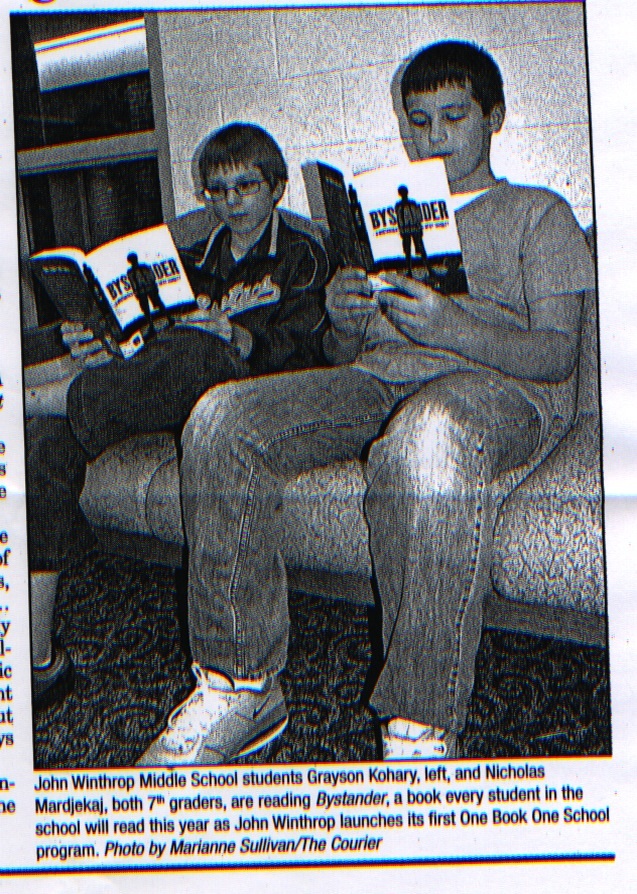
But as I’ve said before, I wrote a book. A story. Not a brochure on how to make your school a “bully-free zone.”
Despite the amazing letters I receive, I still wonder what I can say on a school visit that won’t come off as yet another lecture to this audience. What can I say that might make a difference. And if, perhaps, they simply can’t hear it anymore.

Is it worth beating on that same old drum?
Then I opened up The New York Times and read Nicholas D. Kristof’s op-ed piece from Thursday, May 17. And I’m reminded, yet again, why this matters so very much; and how real people — the children in our village – are powerfully effected every single day; and that anything we can do is far, far better than sad resignation.
As an author and father of three children, ages 11, 12, and 19, I believe that the core of this issue comes back to simple values. Do unto others. The importance of thinking to yourself, “How would that make me feel?” Identifying with others. Caring. Our fundamental humanity.
The issue of bullying is about the importance of compassion, tolerance, kindness, and empathy — at a time in life when empathy does not come easily to many middle schoolers. Stories can help. Like Wonder, by R. J. Palacio, to cite one recent, brilliant work of children’s literature. I read it recently and then pressed it into my 5th-grade daughter’s hands. You must read this, I said. I loved the way, like any great book, Wonder brought us into the hearts and minds of different characters

By: James Preller,
on 3/22/2012
Blog:
James Preller's Blog
(
Login to Add to MyJacketFlap)
JacketFlap tags:
James Preller Address,
Teacher letters,
bullying,
Fan Mail,
School Visits,
Bystander,
Preller Fan Mail,
Fan Mail Wednesday,
James Preller school visits,
James Preller Fan Mail,
Response to Bystander,
Add a tag

I’ve been getting a lot of mail from teachers who are using Bystander in their classrooms. From early on, that was my hope for this book — a talking book, a valuable conversation starter in the hands of a good teacher and a lively classroom. I’m happy to see that it’s been embraced in the 5th grade, as well some 4th-grade classrooms. Overall, most readers seem to be in grades 6-8.
Here’s a sampling of emails from teachers I’ve received over the past few weeks. As always, some personal info has been deleted to protect the innocent . . .

Hi James,
I’m a 4th grade teacher in Iowa. Today I started reading Bystander aloud to the class. I think this is my 3rd year in a row reading the book and I LOVE IT!!! As the kids were listening their mouths were ajar. (I love that!)
Thanks for sharing your awesome talent –- with such an important message.
Cheers,
K
And from Hawaii . . .

Dear Mr Preller,
My name is ____ ______ and I am a 5th grade teacher on the island of Oahu, Hawaii. I am currently reading the book with my students and I have some students who would like to write you some “fan-mail” and replies to reading your book. On your web site you do not have an address in which we could mail you. Could you possibly email me your address?
Any help would be much appreciated. Thanks so much!
Love the book! My students cannot put it down!
Sincerely,
G
I replied: James Preller, 12 Brookside Drive, Delmar, NY 12054.
I also might have added something about being available for school visits. Aloha, baby.
Hi James! I teach fifth grade and we read Bystander as a class. They LOVED LOVED LOVED it. You are a rock star. One of my students took the initiative to write you a letter but I cannot find the address to send it. He even included a self-addressed stamped envelope in the hopes of hearing from you. Can you please send me the address? I would really appreciate it.
V
And lastly, from the Windy City . . .

Mr. Preller,
I would like to inquire about having you come to visit our middle school in late Augus




































































